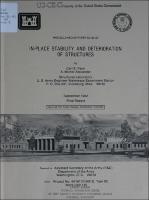Please use this identifier to cite or link to this item:
https://hdl.handle.net/11681/11115| Title: | In-place stability and deterioration of structures |
| Authors: | United States. Assistant Secretary of the Army (R & D) Pace, Carl E. Alexander, A. Michel |
| Keywords: | Acceleration transducers Force transducers Sliding Boundary conditions Impact loads Stability Concrete deterioration Impedance Support conditions Dynamic analysis Modal analysis Mathematical models Numerical models Fast Fourier transformations Safety factor Structural stability Structural analysis |
| Publisher: | Structures Laboratory (U.S.) Engineer Research and Development Center (U.S.) |
| Series/Report no.: | Miscellaneous paper (U.S. Army Engineer Waterways Experiment Station) ; SL-82-20. |
| Description: | Miscellaneous Paper Abstract: Most old lock and dam structures do not meet current design requirements for stability. Since it is important that current stability requirements are met to assure structural safety, most of these structures must be modified to increase their resistance to sliding and overturning. These modifications are very expensive and could possibly be avoided if a more exact stability evaluation could be determined. The stability of structures is presently evaluated by conventional rigid body stability computations, which require many assumptions that may be too conservative. For example, the base of the structure is considered flat when, in fact, it may be irregular and keyed into the foundation giving a much greater resistance to sliding. A procedure for determining in-place stability could be very attractive and cost-effective. A good background in stability evaluation is a prerequisite to beginning in-place stability studies. A brief summary of conventional stability evaluations and some comments about their strengths and weaknesses are presented. This study verified that in-place stability evaluations can be made. Tests were performed to evaluate in-place stability in the frequency domain. The only realistic evaluation was to determine displacement at zero frequency (ω = 0 , static condition). This was not successful because the equipment available for this study would not allow a good definition of D/F close to ω = 0 . Other equipment and some development of measurement techniques would allow a good definition of D/F close to ω = 0. The time domain was then investigated and an in-place stability relationship was determined. The ratio of peak dynamic displacement and force, when plotted against ultimate static sliding resistance, gave a good relationship for a wide variety of interface conditions. Some details of this relationship should be evaluated but are beyond the scope of this study. When considering changes in the condition of structures, the first concept in the evaluation is the effect of boundary conditions on evaluating parameters. All structures have interface (boundary) conditions, for example, a structure founded on rock. If the possible magnitude of these boundary conditions is not known, one will not know what parameter change is due to changes in the boundary condition or the structure itself. The base boundary condition for excitations parallel to the base is the main one associated with a lot ot lock and dam monoliths and is the only boundary condition investigated in this study. In the past, the main parameter that has been used to obtain an indication of the changed condition of a given structure is its natural frequency. The natural frequency is not affected by significant changes in the base condition of the structure. The damping is affected by boundary conditions, but is also affected by many other parameters which will need to be investigated in more detail in the future. |
| Rights: | Approved for public release; distribution is unlimited. |
| URI: | http://hdl.handle.net/11681/11115 |
| Appears in Collections: | Miscellaneous Paper |
Files in This Item:
| File | Description | Size | Format | |
|---|---|---|---|---|
| MP-SL-82-20.pdf | 6.55 MB | Adobe PDF |  View/Open |